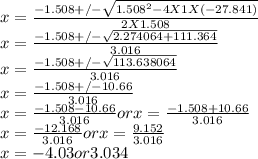
Physics, 25.06.2021 20:40 lucarignot
Lauren pushed a crate of mass 28.9 kg a distance of 2.7 meters along a horizontal surface. On that part of the surface, the crate could slide with negligible friction. Lauren exerted a constant force of 121 newtons for 2.7 meters. The crate then slid down an inclined plane of height 1.8 meters, also with negligible friction. As the crate slid down the plane, the only significant forces on it were the normal force from the plane and gravity (with g = 9.81 meters per second squared). At the bottom of the incline, the crate began sliding along a horizontal surface with ordinary kinetic friction. The coefficient of friction between this surface and the crate was 0.41. This surface ended at a vertical wall after a distance of d2 = 5.2 meters but the crate did not slide that far. Attached to the vertical wall was a long ideal spring with length dy = 3.4 meters and a spring constant of 154 newtons per meter.
Required:
Calculate the distance that the crate compressed the spring before coming to rest.

Answers: 2


Another question on Physics

Physics, 21.06.2019 22:50
Two horizontal plates with infinite length and width are separated by a distance h in the z direction. the bottom plate is moving at a velocity u. the incompressible fluid trapped between the plates is moving in the positive x-direction with the bottom plate. align gravity with positive z. assume that the flow is fully-developed and laminar. if the systems operates at steady state and the pressure gradient in x-direction can be ignored, do the following: 1. sketch your system 2. identify the coordinate system to be used. 3. show your coordinates and origin point on the sketch. list all your assumptions. 5. apply the continuity equation to your system. nts of navier stokes equations of choice to your system 7. solve the resulting differential equation to obtain the velocity profile within the system make sure to list your boundary conditions. check units of velocity 8. describe the velocity profile you obtain using engineering terminology. sketch that on the same sketch you provided in (1). 9. obtain the equation that describes the volumetric flow rate in the system. check the units.
Answers: 2

Physics, 22.06.2019 08:50
The experiment was repeated many years later but the gases were mixed in a different type of container. a white solid was obtained which was xenon fluoride. predict whether you think 1) krypton and 2) radon will react with fluorine. explain reasons for your predictions
Answers: 3

Physics, 22.06.2019 11:30
This punnett square shows the cross between two pants. one parent has round seeds (rr). and the other parent has wrinkled seeds (rr) which best describes their offspring as shown in this cross?
Answers: 2

You know the right answer?
Lauren pushed a crate of mass 28.9 kg a distance of 2.7 meters along a horizontal surface. On that p...
Questions

Mathematics, 07.01.2020 06:31


Mathematics, 07.01.2020 06:31


Mathematics, 07.01.2020 06:31


Mathematics, 07.01.2020 06:31


Mathematics, 07.01.2020 06:31









Business, 07.01.2020 06:31





